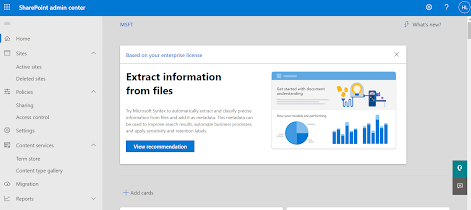Azure Storage Services - Part 1
In this article and subsequent a few articles, will talk about some important objects of Azure Storage Service and it's utility. This is actually kind of learning hand book.
Azure Storage
Services
Microsoft Azure Storage is a
managed service that provides durable, secure, and salable storage in the
cloud.
A single Azure subscription can
host up to 200 storage accounts, each of which can hold 500 TB of data. If you
have a business case, you can talk to the Azure Storage team and get approval
for up to 250 storage accounts in a subscription, which pushes your max storage
up to 125 Petabytes!
Azure data services: Azure storage includes four types of data:
- Blobs: A massively scalable object store for text and binary data.
- Files: Managed file shares for cloud or on-premises deployments.
- Queues: A messaging store for reliable messaging between application components.
- Tables: A NoSQL store for schemaless storage of structured
·
Serving images or documents directly to a
browser, including full static websites.
·
Storing files for distributed access.
·
Streaming video and audio.
·
Storing data for backup and restoration,
disaster recovery, and archiving.
·
Storing data for analysis by an on-premises or
Azure-hosted service.
Azure Storage supports three kinds
of blobs:
·
Block blobs
·
Page blob
·
Append blobs
Files: Enables you to set up highly
available network file shares that can be accessed by using the standard Server
Message Block (SMB) protocol. You can also read the files using the REST
interface or the storage client libraries. You can also associate a unique URL
to any file to allow fine-grained access to a private file for a set period of
time. File shares can be used for many common scenarios:
·
Storing shared configuration files for VMs,
tools, or utilities so that everyone is using the same version.
·
Log files such as diagnostics, metrics, and
crash dumps.
·
Shared data between on-premises applications and
Azure VMs to allow migration of apps to the cloud over a period of time.
Queues: The
Azure Queue service is used to store and retrieve messages. Queue messages can
be up to 64 KB in size, and a queue can contain millions of messages. Queues
are generally used to store lists of messages to be processed asynchronously.
You can use queues to loosely connect different
parts of your application together. For example, we could perform image
processing on the photos uploaded by our users. Perhaps we want to provide some
sort of face detection or tagging capability, so people can search through all
the images they have stored in our service. We could use queues to pass
messages to our image processing service to let it know that new images have
been uploaded and are ready for processing. This sort of architecture would
allow you to develop and update each part of the service independently.


Comments
Post a Comment